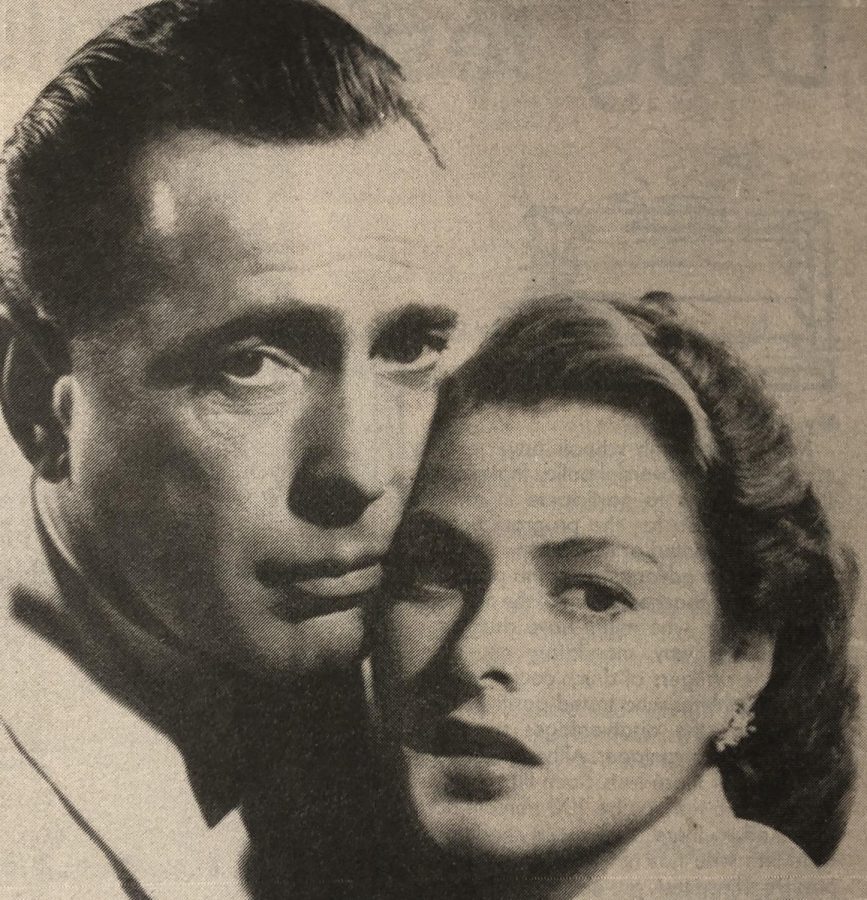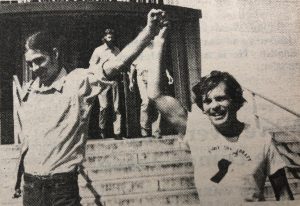THROWBACK THURSDAY: Computer colors movies
Rainbow revivals of classic films had ’80s Knights divided
Humphrey Bogart and Ingrid Bergman starred in the 1957 classic, “Casablanca.” The movie was filmed in black-and-white and was colorized by Turner Broadcasting. Photo courtesy of American-Statesman and caption by unknown staff writer.
May 11, 2023
In Hollywood’s attempt to capture a younger audience, some movie and television firms have decided to add a dazzling array of rainbow shades to be classic black-and-white films. This will be made possible by a computer using an electronic palette of 50,000 colors and a set designer’s eye for detail.
Yet some viewers feel the addition of color to the films is not the greatest.
“They are made in black-and-white, they should stay. They can’t get the colors correct,” senior Ann White said.
“The colors are off,” sophomore Colin Schott said, referring to the mentioning of a blond woman in the movie “Topper.” But due to the addition of color, she had gray hair.
“The color doesn’t look right. The people’s eyes are really weird,” senior Natalie Bradford said.
Two computer companies have independently developed a film colorization process which will add colors to movies and television programs. The colorization process is a highly advanced version of painting by numbers. Each movie can contain 125,000 frames, and each frame can contain up to 525,000 pixels or dots.
Once a single frame has been colored, the computer keeps a record of each object and its designated color as it advances from frame to frame until the scene changes. The conversion process can take hours for a minute of film.
Versions of “Topper,” “Yankee Doodle Dandy,” “Miracle on 34th Street” as well as many Laurel and Hardy films and early newsreel footage have already been colorized. Versions of “The Twilight Zone,” “The Honeymooners” and “The Phil Silvers Show” are hopefuls for colorization.
Turner Broadcasting Systems has also announced plans to add computer generated color to more than 100 films including “Casablanca” and “The Maltese Falcon.”
Charles Powell of Color Systems Technology in Los Angeles believes “a color broadcasting of “Casablanca” would be the television event of the year.” (Science and Technology/1986) But not everyone is happy with the process. Actor Jimmy Stewart, best known for his performance in “Mr. Smith Goes to Washington,” and a group of directors and cinematographers at the American Film Institute object to computer coloring of black-and-white movie colors. Stewart is mostly concerned about plans to add color to “It’s a Wonderful Life,” a 1946 film classic in which he had a starring role. Stewart claims there is only one way to view the movie, in black-and-white.
“It destroys the vintage quality of the movies,” junior Emily Chick said.
Meanwhile Powell and his associates at Systems Technology argue that “the technique gives a realistic new dimension to movies. Many young viewers today won’t look at a black-and-white film, even though they are some of the greatest movies made.” (Science and Technology/1986)
Some film buffs say that colorizing “Citizen Kane“or “Treasure of Sierra Madre” would destroy the artistic and emotional impact of the films.
“Some movies made in black-and-white would change if color were added to the movie. It ruins the original effect,” sophomore Angela Ely said.
Yet people like Powell predict that adding color to some motion pictures will attract enormous audiences. Also, since one-third of all films are in black-and-white, the market could prove to be a profitable venture.
Color Systems plans to market the technique in other ways too. A spin-off of the process may be used by Hughes Aircraft to design a flight simulator for training pilots. Also, the technique might be used with fiber-optic probes in delicate surgical procedures. (Science and Technology/1986)
This story was originally published in the Shield on Oct. 31, 1986.







